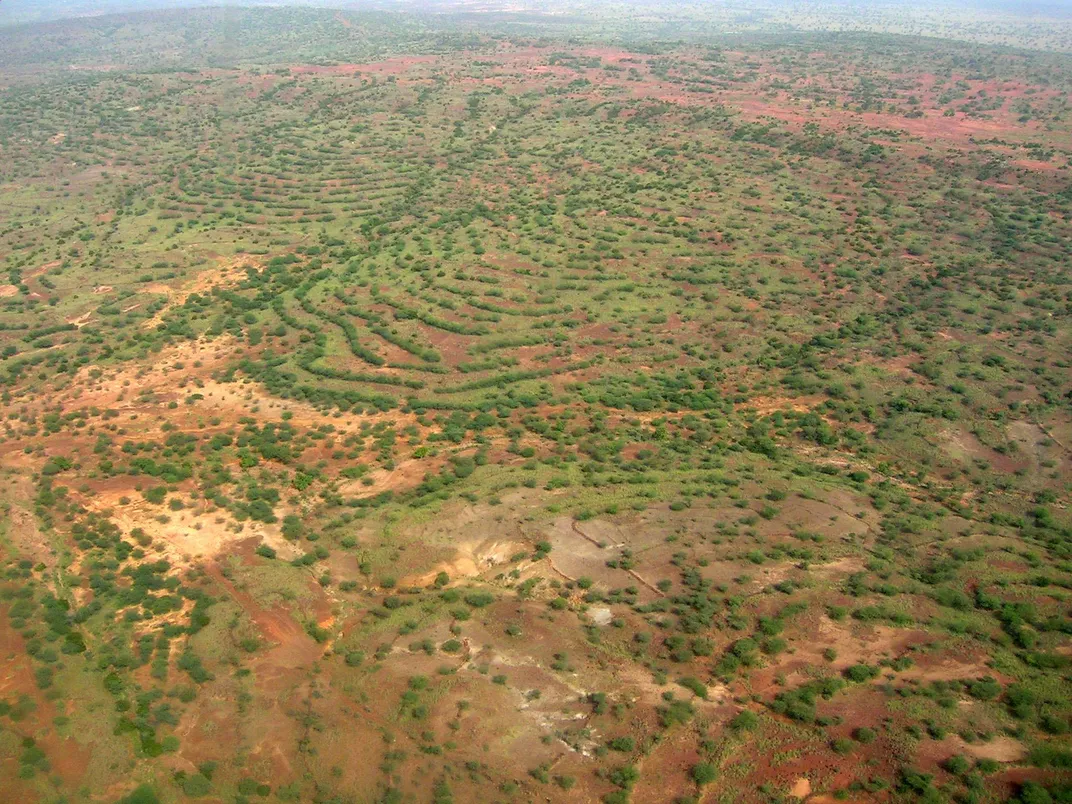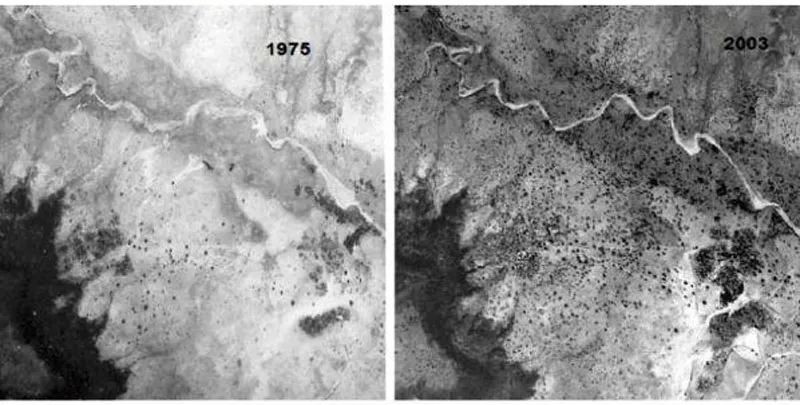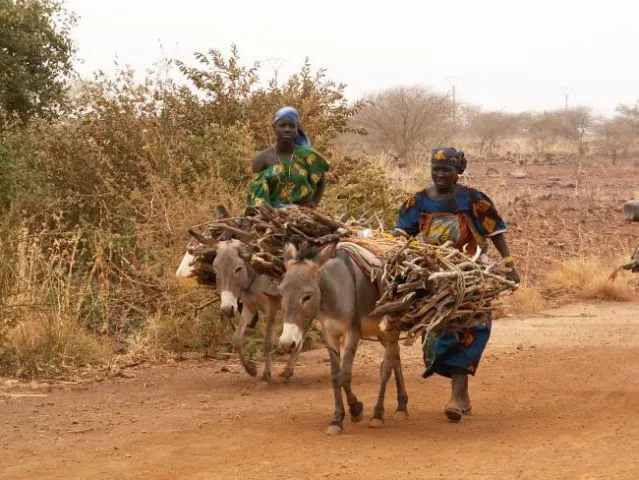The “Great Green Wall” Didn’t Stop Desertification, but it Evolved Into Something That Might
The multibillion-dollar effort to plant a 4,000-mile-long wall of trees hit some snags along the way, but there’s still hope
/https://tf-cmsv2-smithsonianmag-media.s3.amazonaws.com/filer/6d/b9/6db93c2c-e359-4314-ac8c-aeb8262138bf/ficus_pour_7_moutons.jpg)
It was a simple plan to combat a complex problem. The plan: plant a Great Green Wall of trees 10 miles wide and 4,350 miles long, bisecting a dozen countries from Senegal in the west to Djibouti in the east. The problem: the creeping desertification across Africa.
“The desert is a spreading cancer,” Abdoulaye Wade, Senegal's president and the wall's standard bearer, said. “We must fight it. That is why we have decided to join in this titanic battle.”
There were just a few problems.
Planting trees across the Sahel, the arid savanna on the south border of the Sahara Desert, had no chance to succeed. There was little funding. There was no science suggesting it would work. Moreover, the desert was not actually moving south; instead, overuse was denuding the land. Large chunks of the proposed "wall" were uninhabited, meaning no one would be there to care for the saplings.
Soon after Wade began touting the tree planting plan, scientists began dissenting.
"This was a stupid way of restoring land in the Sahel," says Dennis Garrity, a senior research fellow at the World Agroforestry Centre.
"If all the trees that had been planted in the Sahara since the early 1980s had survived, it would look like Amazonia," adds Chris Reij, a sustainable land management specialist and senior fellow at the World Resources Institutewho has been working in Africa since 1978. "Essentially 80 percent or more of planted trees have died."
Reij, Garrity and other scientists working on the ground knew what Wade and other political leaders did not: that farmers in Niger and Burkina Faso, in particular, had discovered a cheap, effective way to regreen the Sahel. They did so by using simple water harvesting techniques and protecting trees that emerged naturally on their farms.
Slowly, the idea of a Great Green Wall has changed into a program centered around indigenous land use techniques, not planting a forest on the edge of a desert. The African Union and the United Nation's Food and Agriculture Organization now refer to it as "Africa’s flagship initiative to combat land degradation, desertification and drought." Incredibly, the Great Green Wall—or some form of it—appears to be working.
"We moved the vision of the Great Green Wall from one that was impractical to one that was practical," says Mohamed Bakarr, the lead environmental specialist for Global Environment Facility, the organization that examines the environmental benefit of World Bank projects. "It is not necessarily a physical wall, but rather a mosaic of land use practices that ultimately will meet the expectations of a wall. It has been transformed into a metaphorical thing."

The Sahel spans 3,360 miles from the Atlantic Ocean to the Indian Ocean, a belt stretching across the southern edge of the Sahara. Rainfall is low, from four to 24 inches per year, and droughts are frequent. Climate change means greater extremes of rainfall as the population skyrockets in the region, one of the poorest in the world. Food security is an urgent concern. By 2050, the population could leap to 340 million, up from 30 million in 1950 and 135 million today.
Reij, now based in Amsterdam, began working in the Sahel when the soil literally was blowing away during dust storms. After years away, Reij returned to Niger and Burkina Faso in the summer of 2004. He was stunned by what he saw, green where there had been nothing but tan, denuded land. He quickly secured funding for the first of several studies looking at farming in villages throughout Burkina Faso and Niger.
For help, he called on another veteran of Africa, Gray Tappan, a geographer with the U.S. Geological Survey's West Africa Land Use and Land Cover Trends Project. Flying over villages and then driving from one to the other, Tappan says they were “charmed” by what they saw. On the ground, they couldn’t see villages from a distance because there was too much vegetation.
Over two years traveling through Burkina Faso and Niger, they uncovered a remarkable metamorphosis. Hundreds of thousands of farmers had embraced ingenious modifications of traditional agriculture practices, transforming large swaths into productive land, improving food and fuel production for about 3 million people.
"This regreening went on under our radar, everyone's radar, because we weren't using detailed enough satellite imagery. We were looking at general land use patterns, but we couldn't see the trees," Tappan says. "When we began to do aerial photography and field surveys, then we realized, boy, there is something very, very special going on here. These landscapes are really being transformed."

Innovative farmers in Burkina Faso had adapted years earlier by necessity. They built zai, a grid of deep planting pits across rock-hard plots of land that enhanced water infiltration and retention during dry periods. They built stone barriers around fields to contain runoff and increase infiltration from rain.
In Niger, Reij and Tappan discovered what has become a central part of the new Great Green Wall campaign: farmer-managed natural regeneration, a middle ground between clearing the land and letting it go wild.
Farmers in the Sahel had learned from French colonists to clear land for agriculture and keep crops separate from trees. Under French colonial law and new laws that countries adopted after independence, any trees on a farmer's property belonged to the government. Farmers who cut down a tree for fuel would be threatened with jail. The idea was to preserve forests; it had the opposite effect.
"This was a terrific negative incentive to have a tree," Garrity says, during an interview from his Nairobi office. "For years and years, tree populations were declining."
But over decades without the shelter of trees, the topsoil dried up and blew away. Rainfall ran off instead of soaking into cropland. When Reij arrived in Africa, crop yields were less than 400 pounds per acre (compared to 5,600 pounds per acre in the United States) and water levels in wells were dropping by three feet per year.
In the early 1980s, as village populations increased and land productivity decreased, Reij says farmers turned to a low-cost way of growing trees and shrubs, using root stock in their cleared fields. The trees provided fuel, fodder for livestock, food, and soil improvement.
When Tappan compared aerial images he took in 2004 with those from as far back as 1950, he was blown away. Huge swaths once tan were green. Niger’s Zinder Valley had 50 times more trees than it did in 1975.
To figure out how the practice became widespread, Reij and Tappan did a bit of cultural archaeology. They learned it had originated with Tony Rinaudo, an Australian with Serving in Mission, a religious nonprofit. Rinaudo, working with local farmers, had helped the farmers identify useful species of trees in the stumps in their fields, protect them, and then prune them to promote growth. Farmers grew other crops around the trees.
Rinaudo returned to Australia in 1999, unaware of the extensive effect of his work (Reij would not meet him until 2006 when they began working on regreening initiatives). By the time Reij and Tappan took their first trip across part of Niger, farmer regeneration had been shared, from farmer to farmer, for about three decades. "We were mesmerized by what we were seeing," Tappan says of that first trip. "It was stunning to see the amount of work in terms of soil and water conservation, water harvesting practices as well as natural regeneration of trees."
Garrity recalls walking through farms in Niger, fields of grains like millet and sorghum stretching to the sun planted around trees, anywhere from a handful to 80 per acre. “In most cases, the trees are in random locations because they sprouted and the farmer protected them and let them grow,” he says. The trees can be cut for fuel, freeing women who once spent two and a half hours a day collecting wood to do other tasks. They can be pruned for livestock fodder. Their leaves and fruit are nutritious.

One tree, Faidherbia albida, goes dormant during the wet season when most trees grow. When the rains begin, the trees defoliate, dropping leaves that fertilize the soil. Because they have dropped their leaves, the trees do not shade crops during the growing season. Their value had long been recognized by farmers, he says, but they were never encouraged to use them.
Reij and Tappan discovered the regreening mostly stopped at the southern border with Nigeria, where there is more rainfall, which was counterintuitive, Tappan says. More precipitation should mean more vegetation. "It wasn't about rainfall," he adds. "It was absolutely about farmers changing the way they manage trees and their perception of the trees."
Tappan remembers giving a presentation to the U.S. Embassy in Niamey, Niger, showing aerial views of one green swath after another. "The comments were, 'this can't be Niger,'" he says. "It looks like Ireland."
From 2004 on, they published a series of research papers and reports sounding the call about the transformation. Reij says that by 2011, there were more than 12 million acres restored in Niger alone. More than 1.2 million were restored in Mali, but no one knew until 2010 because no one looked.
The key, Reij says, is scaling up the effort in the drylands countries by building up grassroots efforts, addressing the legal issues (like tree ownership), and creating markets for the products of agroforestry. "We've never seen anything near this size and impact on the environment anywhere in west Africa," Tappan adds. "In our mind Niger already has its great green wall. It's only a matter of scaling it up."
Reij says the World Bank—which has committed $1.2 billion to the effort—the Global Environment Facility and others are convinced natural regeneration is an important way forward, but the approaches are up to each country. At the African Union, Elvis Paul Tangem, coordinator of the Great Green Wall for the Sahara and Sahel Initiative, says that 21 countries now have projects within the framework of the initiative.
Tangem concedes that projects in countries like Niger, Senegal, Burkina Faso, and Mali are much more advanced than others. Cameroon and Ghana, he adds in an interview from his office in Addis Ababa, began work just this year.
Reij says the answer lies with helping farmers do what they're already doing and spreading the word."If you want to regreen, do it quickly and effectively and at a reasonable cost, the only way forward is natural regeneration on farms," Reij says from his office in Amsterdam. "Put responsibility in the hands of the farmers. They know what their best interests are. Conventional projects will not make a difference here."
He laments that work is moving too slowly. With the Sahel's population doubling in 20 years, Reij says regreening needs to be finished within 10 to 15 years.
"But looking at what has been achieved in the last 20 years in the Sahel, the large-scale restoration in Niger, Burkina Faso, and Mali,” he adds, “I am more optimistic now than when I started working in the Sahel in 1978."
/https://tf-cmsv2-smithsonianmag-media.s3.amazonaws.com/accounts/headshot/jim-morrison-240.jpg)
/https://tf-cmsv2-smithsonianmag-media.s3.amazonaws.com/accounts/headshot/jim-morrison-240.jpg)